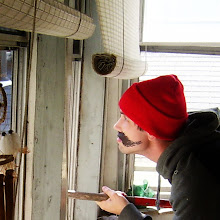The biggest difficulty in creating a non-computer reliant version of this game has been in the incorporation of a meaningful end-game condition.
In class, it was apparent that the game lacked a strong enough connection to the philosophy that the game is supposed to model. To fix this I've come up with an idea, but its incorporation into the game initially appears very difficult.
The idea would change the goal of the game from winning points (never seriously considered) to ordering the board, which would bring the focus of the game to the two main concepts of the philosophy: creating order by finding connections. The difficulty is that this could make the game very frustrating, or impossible. It also ruins the idea of having a "print-out" of the game board since the board would be changing.
The idea (still in cloudy form):
In the current rules (see below), finding a connection (same ratio symbol as opponent) gives you a point and gives you your opponent's bead. In this idea, instead of getting their bead you would get the symbol under their bead. Acquired symbols would be like a player's bag of tricks; if an opponent puts a bead on a space that has a unique ratio (or whatever the "connecting" criteria is), the player might be able to place their symbol back onto the board in such a way that it creates a connection for them.
Theoretically this works wonderfully, and philosophically it's solid as solid can be, but the nitty-gritty rules that make it work could be very confusing or difficult to satisfy in-game. I can see this addition to the game making the game last forever, which is good and bad; good because that's accurate to the book--the games could go on for weeks--and bad because it might dissuade people from playing.
*tangent: if this is the case, and the game lasts forever, an internet version of the game would be ideal. I'm thinking about those flash games where 100's of people try to spell a word on a virtual refrigerator door. Similarly, the game might be played in real time, with the board changing and pieces flying everywhere, the goal being to create your own patterns, or to create one pattern cooperatively.*
I suppose the next step is to try out this idea and work out the nitty-gritty rules of it.
Wednesday, January 30, 2008
Subscribe to:
Post Comments (Atom)

No comments:
Post a Comment